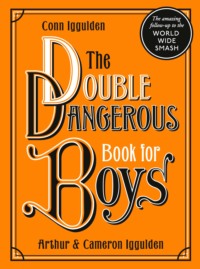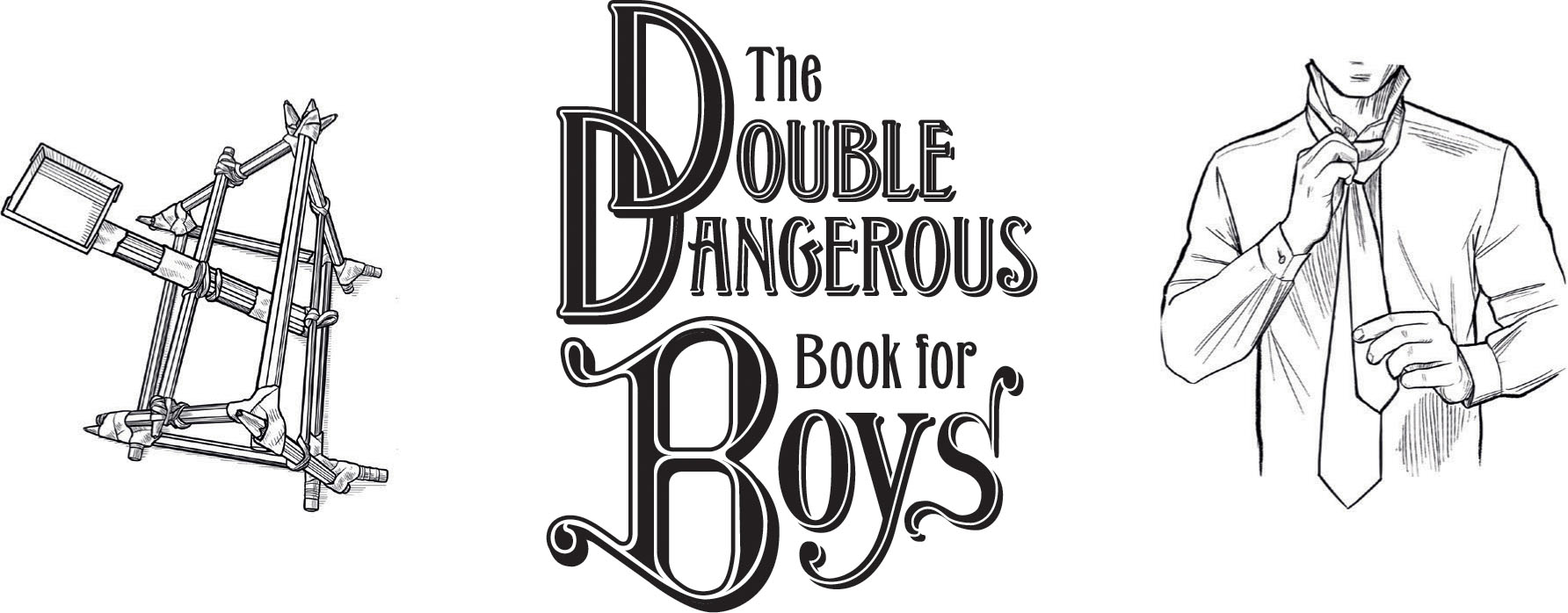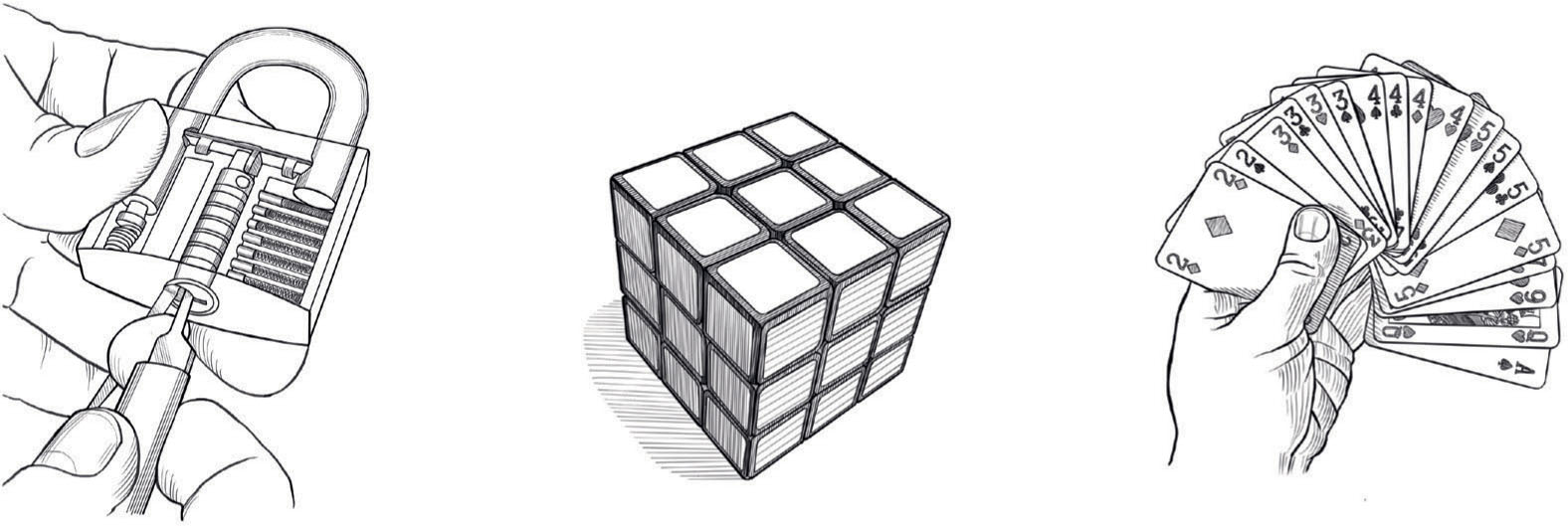
The Double Dangerous Book for Boys


COPYRIGHT
HarperCollinsPublishers
1 London Bridge Street
London SE1 9GF
www.harpercollins.co.uk
First published by HarperCollinsPublishers 2019
FIRST EDITION
Text © Conn Iggulden, Arthur Iggulden and Cameron Iggulden, 2019
Illustrations © Nicolette Caven, 2019
Cover and internal design © Simeon Greenaway
A catalogue record of this book is available from the British Library
The authors assert the moral right to be identified as the authors of this work
All rights reserved under International and Pan-American Copyright Conventions. By payment of the required fees, you have been granted the nonexclusive, non-transferable right to access and read the text of this e-book on screen. No part of this text may be reproduced, transmitted, downloaded, decompiled, reverse engineered, or stored in or introduced into any information storage retrieval system, in any form or by any means, whether electronic or mechanical, now known or hereinafter invented, without the express written permission of HarperCollins e-books.
Find out about HarperCollins and the environment at www.harpercollins.co.uk/green
Source ISBN: 9780008332983
Ebook Edition © October 2019 ISBN: 9780008299682
Version 2019-10-28
CONTENTS
Cover
Title Page
Copyright
Epigraph
Introduction
Notes from the Treehouse
Picking Locks
Extraordinary Stories – Part One: Ernest Shackleton
Old British Coins
Flying Machines
Questions About the World – Part One: What is the tallest mountain on earth? Why does the earth have a magnetic field? Where are the hottest and the coldest places on earth? What was Pangaea? Is the earth slowing down? What are the longest rivers?
Tying a Windsor Knot
Advice from Fighting Men
Kintsugi
The Fastest Laces in the West
Finding the Height of a Tree
How to Start a Fire with a Battery
Questions About the Law – Part One: Can the Queen be charged with a crime? Is treason still a crime? When can the police stop and search you? What is the highest court authority in Britain? Can you be tried twice for the same crime?
Chess Openings
Great British Trees
Hanging Tools on a Wall
Interesting Chemical Reactions
Regiments of the British Army
Making a Board Game
Great Tales of the Past
Making a Stink Bomb
Gods of Greece and Rome
Balloon Dog and Sword
Johnny Ball – Maths Puzzles I
Famous Horses
The Rules of Ultimate Frisbee
Solving the Rubik’s Cube
Great Ruins
Things to Do: Two Table Tricks
The Endless Card
The Commonwealth
Stress Balls and Rollers
Three Greek Legends Every Boy Should Know
Things to Do: Two Table Games
Extraordinary Stories – Part Two: Mount Cook, 1982
Making Perfume
Empires of Gold: Akkadian, Persian, Greek, Mayan, Roman, Mongol, Aztec, Ottoman, British
Johnny Ball – Maths Puzzles II
Two Great Card Games: Nomination Whist and Cheat
The Paper Box
Five Great Speeches
Things to Do: Frustration Games
The History of Navigation: The Ancients to the Mars Lander
Casting in Clear Resin
Five More Poems Every Boy Should Know
Famous Battles: Cunaxa, Brunanburh, Towton
The Summer Meal: Starter, Lasagne, Tiramisu
British Birds
Shotguns
Forgotten Explorers
How to Wire a Plug and Make an Inspection Lamp
Writing a Thank-You Letter
Five Great Mathematicians: Pythagoras, Euclid, Newton, Einstein, Hawking
The Best Paper Aeroplane in the World – Take Two
The Twelve Caesars
Jumping Paper Frog
Extraordinary Stories – Part Three: Victor Gregg
More Quotes from Shakespeare
Making an Igloo
British Prime Ministers
Making a Pencil Catapult
British Sign Language
Forty Quotations Worth Knowing
Questions About the Law – Part Two: Does the death penalty still exist? What rights do you have in a police station once you’re under arrest? How and when can you legally use force in self-defence? Who has the right to enter your home and when? What happens if you’re maliciously targeted by the police?
Elastic-Band Gun
Making a Cup of Coffee
Polishing Boots like the British Army
Questions About the World – Part Two: How many active volcanoes are there? How many satellites orbit the earth? How deep can we go? How do we generate electricity? What is the universe made of?
Extraordinary Stories – Part Four: Hunting a King
Johnny Ball – Maths Puzzles III
Strength Exercises Every Boy Should Do
More Books Every Boy Should Read
Things that Didn’t Go In
Imperial and Metric Measures
The Last Word
Acknowledgements
Additional contributors
Picture credits
About the Publisher

In this long-awaited follow-up to his much-loved bestseller, written with his sons Cameron and Arthur, Conn Iggulden presents a brand-new compendium of cunning schemes, projects, tricks, games and tales of extraordinary courage.
Whether it’s building a flying machine, learning how to pick a lock, discovering the world’s greatest speeches or mastering a Rubik’s cube, The Double Dangerous Book for Boys is the ultimate companion, to be cherished by readers and doers of all ages.

EPIGRAPH
‘Boys – you are here to study, and while you are at it, study hard. When you have got the chance to play outside, play hard. Do not forget this, that in the long run the man who shirks his work will shirk his play. I remember a professor in Yale speaking to me of a member of the Yale eleven some years ago, and saying: “That fellow is going to fail. He stands too low in his studies. He is slack there, and he will be slack when it comes to the hard work on the gridiron.” He did fail.
‘You are preparing yourself for the best work of life. During your schooldays, and in after-life, I earnestly believe in each of you having as good a time as possible, but making it come second to doing the best kind of work possible. And in your studies, and in your sports in school, and afterwards in life in doing your work in the great world, it is a safe plan to follow this rule – a rule I once heard preached on the football field: Don’t flinch, don’t foul, and hit the line hard.’
THE ADVICE OF US PRESIDENT THEODORE ROOSEVELT, GIVEN TO THE READERS OF THE BOY’S OWN PAPER IN 1903
INTRODUCTION
In 2006, there didn’t seem to be many books of the kind I used to love. I wanted adventures, catapults, crystals, knowledge, history and craftsmanship. I wanted to read dozens of chapters, each different from the last. In short, I wanted a book I could hide in a treehouse – after I’d used it to build one. With my brother Harry, I worked for six months in a shed and wrote chapters on all the things that interested us – from cloud formations and astronomy, to juggling and tripwires. When it was finished, we sent it to the publishers. We didn’t set out to write a bestseller. We just wanted to celebrate the wonderful, daft ideas of boyhood – when all doors are open, the future is unwritten and summers seem to last a really long time.
Thank you to all those who recommended it to friends and family. You made the publisher reprint that red and gold hardback over and over. You gave the book to a wider audience – to sons, grandsons, nephews, brothers and fathers. We said it would appeal to ‘every boy from eight to eighty’ and that was about how it turned out. If I am remembered for just one book, if my tales of Caesar and Genghis and the Wars of the Roses are all forgotten, I don’t mind too much if someone dusts off the Dangerous Book in an attic and settles down to read with a smile.
I wrote this one with my two sons. One has become a young man since the original Dangerous Book came out. The other has reached the age of ten. He runs around like Huckleberry Finn and should wear shoes more often, probably. I thought for a while that I’d covered everything in the first book, but there’s nothing like raising boys for surprising you.
Twelve years have passed since I first roughed out a chapter on conkers for a publisher. I wrote then, ‘In this age of video games and mobile phones, there must still be a place for knots, treehouses and stories of incredible courage.’ That’s just as important today – though how we missed picking a lock, making an elastic-band gun and learning sign language, I’ll never know. In the intervening years, I wrote down a good idea whenever I heard one. Perhaps I always knew I’d go back and do another book. These are all new chapters, from casting things in resin, doing table tricks and wiring a lamp, to learning strength exercises, the twelve Caesars, stress balls and ancient ruins. There is also a design for a paper aeroplane – and, yes, it’s even better than the last one. The world is full of fascinating things. You’ll see.
Conn Iggulden
NOTES FROM THE TREEHOUSE

For us, this has been a chance to act like boys without consequences: to make catapults, build igloos and mix chemicals. We spent two days casting our grandfather’s beans in resin to preserve them for ever, and who knows how many evenings playing cards with our family. We learned to make a paper frog jump and to polish shoes like the British Army.
Yet it was also a chance to show our dad some of the things we knew and he didn’t. Those sunny afternoons the three of us spent learning sign language or struggling to teach him how to solve a Rubik’s cube will be some we never forget. For all that, we are very grateful.
So when we have sons of our own and we pick up this book, what will stay in our minds and our memories will not be individual triumphs and disasters.
No. In the end, what matters most is that we did these things together.
Cameron Iggulden Arthur Iggulden
Конец ознакомительного фрагмента.
Текст предоставлен ООО «ЛитРес».
Прочитайте эту книгу целиком, купив полную легальную версию на ЛитРес.
Безопасно оплатить книгу можно банковской картой Visa, MasterCard, Maestro, со счета мобильного телефона, с платежного терминала, в салоне МТС или Связной, через PayPal, WebMoney, Яндекс.Деньги, QIWI Кошелек, бонусными картами или другим удобным Вам способом.
Вы ознакомились с фрагментом книги.
Для бесплатного чтения открыта только часть текста.
Приобретайте полный текст книги у нашего партнера:
Всего 10 форматов